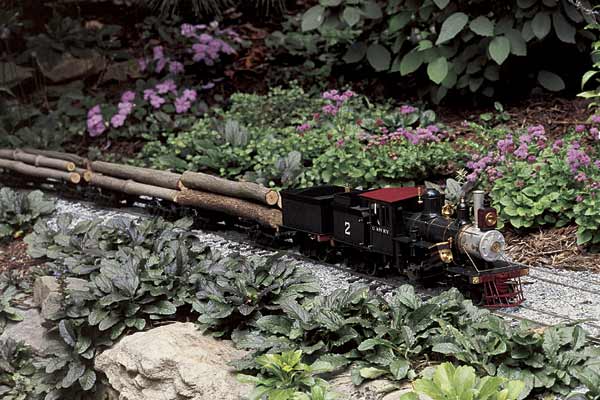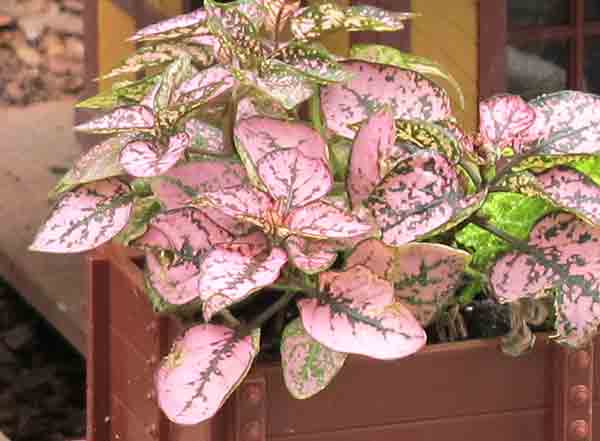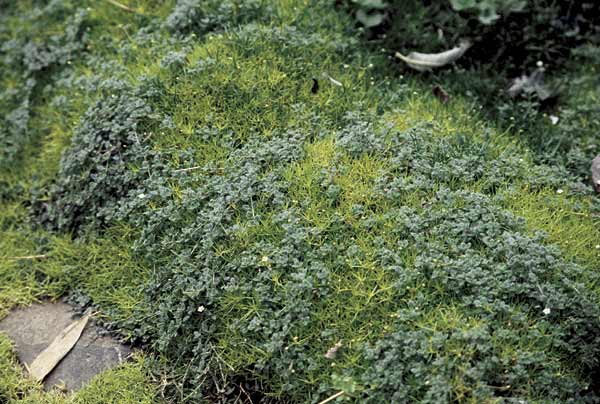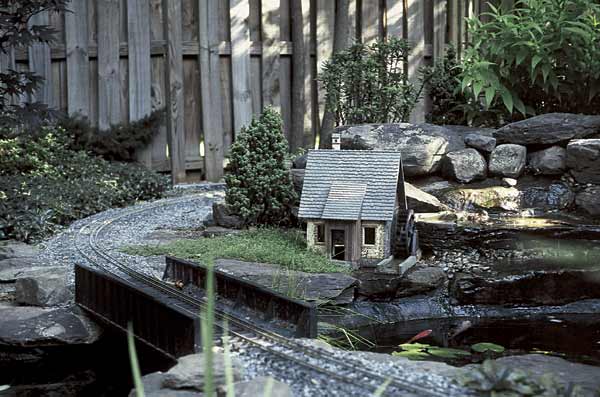A beginner’s guide to plants
For many railway gardeners, the “garden” is the most challenging aspect of a garden railroad. Like all living things, outdoor plants have unpredictable habits; growing, changing, moving, and sometimes even dying on us for no apparent reason. Latin names, horticultural terms, and gardening techniques can be confusing to a beginner. If you’re new to gardening and are eager to learn more, this “Gardening from the ground up” series is written especially for you. A clear understanding of the many types of plants available and how they can be used in a garden railroad will help you be successful in your gardening adventures.
When selecting plants for your garden railroad, you’ll have many issues to consider. Before you buy, you’ll need to know what types of plants to look for. You may be looking for colorful groundcovers to plant trackside, or you may be looking for dwarf evergreen trees to fill out your mountain scene. What function will the plants play in your railroad garden? Garden-railroad plants often need to be small in scale and stature. Which plants will grow slowly and stay dwarf? In addition, you need to understand your soil conditions, moisture supply, and light exposures. Lastly, as with any type of gardening, consider how much time you plan to spend in the garden. If plants are low on your priority scale, be sure to start with the easiest, lowest-maintenance plants first.
A few definitions will help us get started. Most garden railway plants can be grouped into the following categories: annuals, perennials, groundcovers, shrubs and small trees, and conifers. The category, or function, of your plants is critical, especially in garden railroads that emphasize realism and authenticity. It’s also important that you choose the right plant for the right place in order to keep your gardening time enjoyable, rather than an effort or chore.
Annuals

Annuals are those plants that sprout, grow, bloom, set seed, then die, all in one season. They bloom like crazy for months and months, but basically it’s a one-shot deal. Once they finish blooming, it’s often time to pull them out and start over. Some annuals, such as sweet alyssum, marigolds, and others are called “self-seeding.” If left to go to seed, the seed will drop in place and germinate the following year, resulting in new plants the next year in nearly (or sometimes not so nearly) the same places and forms. Generally, however, annuals need to be planted each year.
For railway gardens, annuals with small-scale leaves and flowers seem to look the most appropriate and pleasing. Some best bets are sweet alyssum, ageratum, baby blue eyes, feverfew, felicia, creeping lobelia, dwarf marigolds, portulaca, sanvitalia (creeping zinnia), and dwarf annual daisies. Annuals generally require more care than perennials, requiring diligent attention to water and fertilizer to stay healthy and blooming. In addition, regular “deadheading,” or removing spent blossoms, will keep the plants in flower longer.
Perennials

Flowering plants that come back year after year are called perennials. They can be short or long-lived, depending on the climatic conditions and the variety. Perennials are often listed with a hardiness zone rating, so it’s well worth your while to learn your hardiness zone and, in the beginning, to buy only plants that are hardy in your area. The USDA ratings are based on minimum temperatures and range from 1-10, with 1 being the coldest. (Click on “Plant Hardiness” below for more on hardiness zones.) Some old-fashioned favorites, such as peonies and irises, can live for decades with little or no care. (While I was in college, I rented the childhood home of a 92-year old man. He could remember the same peonies and roses we enjoyed from when he was young!)
While annuals bloom all season, they are basically static and unchanging. Once they come into bloom, they keep going until they stop, then they die. Perennials, on the other hand, bring action to a garden by changing from one season to the next. In the spring, many often emerge from their winter dormancy with colorful new growth. Most are spring or summer bloomers, but fall and even winter bloomers exist among perennial choices.
Some perennials will be attractive all summer, even when not in bloom; others will come up, bloom for a short time, and then disappear just as quickly. Though there are thousands of varieties to choose from, you will easily come to recognize those that will be the most attractive in your own garden railroad. Again, the key is to look for plants with small-scale features, including foliage, overall stature, and flower size. “Rock garden” plants are a great group to start with because they are almost always low to the ground and miniature in scale. Perennials are easy to care for once they’re established (generally after the first full year), but do require some cleaning up as the leaves and flowers fade.
Groundcovers

In most railroad gardens living groundcovers play an extremely important role. Irish and Scotch mosses, creeping thymes, and sedums, for example, are regularly used to cover miniature embankments, trail over G-scale cliffs, and even to represent trackside meadows and prairies. Luckily for us, many of these groundcovers have tiny leaves and blossoms and fit right into a natural railroad setting. Many groundcovers will stay under one inch tall and can spread up to several feet in width. They can be green all year long (evergreen), or they can go dormant for part of the year. Some, such as Corsican mint and creeping lemon thyme, can take some foot traffic and, when crushed, will release a sweet fragrance on warm days. When selecting groundcovers for scale-sensitive areas, be sure to look for tight growers with short internodes (the stem length between sets of leaves). No living groundcover is maintenance-free, however, so be prepared for occasional cleaning up or replanting as the years go by.
Herbs are a wonderful group to search through when looking for small-scale plants. These are defined as plants that at some time in history have been considered valuable for medicine, fragrance, household use, or seasonings. Some are annuals; many are hardy and adaptable perennial plants. Most are sun-loving, but sweet woodruff and even chamomile will tolerate shade. Oregano, thymes, and creeping rosemary are groundcovers for sun, while santolina, germander, lavender, and even scented geraniums can be used as small shrubs or tiny G-scale trees.
Shrubs and trees
When it comes to shrubs and small trees, garden railroaders have hundreds of varieties to choose from. It all comes down to how hard you want to work to keep your plants small, or to selecting dwarf and miniature plants at the outset. Most railway-garden “trees” are actually shrubs that have been selectively pruned to form a trunk and spreading branches. Shrubs are woody plants that increase in size in two ways: by growing new shoots from the base and/or through new buds on old wood. The best large-scale trees often come from miniature or dwarf shrubs that produce few basal shoots and that grow less than 4 inches of new wood per year.
Shrubs and trees can be deciduous (shedding their leaves at one time of the year, usually in the fall) or evergreen (covered with leaves through the year). Evergreens will shed leaves periodically throughout their growing season, but never all at once. Among the evergreens you’ll find broad-leaved plants and conifers. Broad-leaved evergreens, such as rhododendrons and certain euonymus and cotoneasters, offer interest all year round, but tend to be more sensitive to winter extremes.
Conifers

Because they are relatively unchanging, conifers are really the backbone of the garden railway, especially in the winter. Leaves are usually narrow, needle or scale-like, and the seeds are produced in cones or cone-like structures. (Not all conifers are evergreen, though. There are actually five species of conifers that are deciduous!)
If you’ve been reading the plant lists in Garden Railways, you may have noticed a wonderful assortment of small scale conifers to choose from. This is because many conifers tend to mutate, or “sport,” and hundreds of dwarf and miniature varieties have been selected and are now available through mail order or at your local nursery. Most of these have tiny leaves that are wonderfully in scale with the garden railroad. The American Conifer Society recently established standards of growth for conifers, and have defined “miniature” as growing less than 3 inches per year, and “dwarf” as growing 3 to 6 inches per year, so keep these in mind as you read plant labels and mail-order forms.
There are hundreds of plants to choose from when designing your railroad garden. With a clearer understanding of how the plants relate to your whole design, the joy of gardening will become an important part of your outdoor railroading experience. Plants are living, changing things, adding surprise and beauty to the railway, a combination that can’t be matched indoors.
Learn more about USDA Hardiness Zones.













